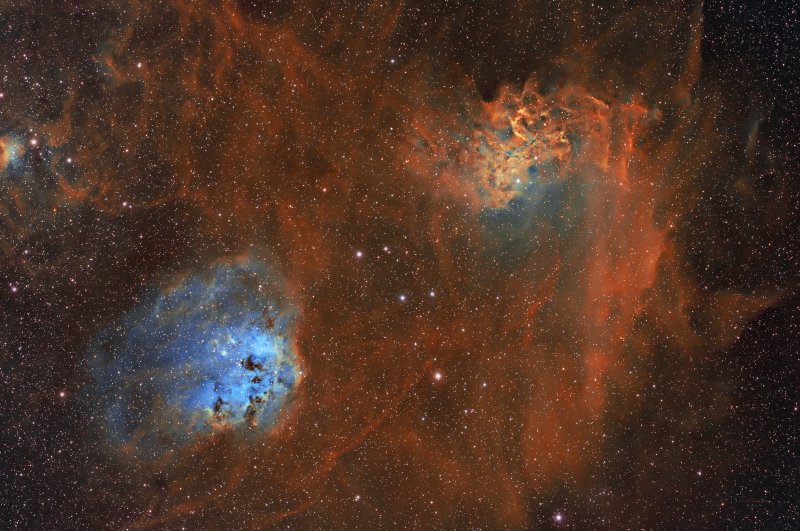A beautiful and colorful image, where the blue hues appear to have been somewhat muted.
An interesting object in today's APOD is the hot binary star Pi Scorpii and the combined emission/reflection nebula that surrounds it.
I really like the way the picture at left emphasizes the components of this cosmic object. There is, of course, the hot blue (binary) star, made up of a B1V and a B2V component. The star is surrounded by a relatively faint red emission nebula, because Pi Sco is not hot enough to produce all the ultraviolet photons needed to ionize a bright emission nebula. And then, in front of the star and the emission nebula, there is a rather dull and gloomy blue reflection nebula, whose dust reflects the bright blue light of the star.
Note how the almost vertical wall of the reflection nebula appears very straight and smooth, as if it was sculpted by a very strong and steady stellar wind. But the wall at left appears to smoking and evaporating. Actually, that is typically what happens to dusty nebulas in the vicinity of very hot stars. Their dust grains are "cooked" to smaller sizes, so that they can no longer reflect blue light. That is why we so rarely see stars that are surrounded by both emission and reflection nebulas.
The Flaming Star Nebula in red and blue.
Photo: Photo: Jim DeLillo.
Rough seas of the Flaming Star Nebula. Photo: J-P Metsavainio.
The reason why the Flaming Star Nebula is both a reflection and an emission nebula is because the hot ionizing star AE Auriga is a runaway star that is just paying a quick visit to the dust cloud that it is lighting up. AE Aurigae is an O-type star, albeit only an O.5V star, but it is nevertheless considerably more powerful than Pi Scorpii. AE Aurigae is leaving the dust cloud in turmoil as it is ploughing right through it, and some contorted dust tendrils are reflecting the bright blue light of the hot star. And a lot of the gas is ionized and made to glow red.
The Flaming Star Nebula and its "nebular neighbour" IC 410 in Hubble palette.
Photo: Mario C. B. Bautista, MD.
Yes, but look at the picture at left of the Flaming Star Nebula and its apparent "nebular neighbour", IC 410. In reality, IC 410 is not only a lot more distant than The Flaming Star Nebula, but it is also a lot more powerful since it contains many hot bright stars. (The Flaming Star nebula contains only one O-type star, AE Aurigae itself.)
Therefore, when photographed in the Hubble palette, IC 410 glows blue from OIII emission. The Flaming Star Nebula, by contrast, has lost (almost) every trace of blue. The bluish hues we do see in the Flaming Star Nebula are due to OIII emission near the hot ionizing star.
Reflection nebulas don't show up in the Hubble palette, however. For that reason, we can expect a Hubble palette image of the nebula around Pi Scorpii to look about as orange as the Flaming Star nebula does in the picture at left. And the interestingly angled reflection nebula around Pi Scorpii simply would be nowhere to be seen.
Ann
 Rho Ophiuchi Wide Field
Rho Ophiuchi Wide Field


